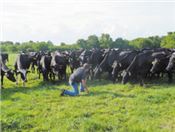|
Change Keeps Monett Farm Growing

Monett farmer Mike Meier used MU Extension practices to improve his dairy operation. He is in the process of
converting his dairy operation to beef by using the same proven research-based methods.
Credit: Photo courtesy of Stacey Hamilton
MONETT, MO.
Fourth-generation farmer Mike Meier knows change will help his family’s Century Farm survive.
The rotational grazing and breeding system he uses for his dairy herd works. Now he wants to apply those principles to beef cattle. “At 56, I wanted to go in a different direction,” he says.
He wants to see how much profit per acre he can make by switching from dairy to beef cattle. He is building his cattle herd as he prepares to sell the dairy herd.
“There will be a learning curve,” he says. “Beef and dairy cows are not the same.”
It is not the first time Meier changed the operation.
He had planned to shut down the 100-year-old family dairy farm in 2005. Conventional dairy farming was time-consuming and not profitable enough to support him, his brother and his father. Mike operated a Rhino spray-on lining company for truck beds, and it was doing well.
Even with the outside business, Meier felt squeezed. Three families split profits from a farm that had previously supported one. He bought out his brother’s share of the dairy. His father retired in 2000, and died in 2010. His property and profits increased, but so did the labor.
Meier began watching practices at the nearby University of Missouri Southwest Research Center. Stacey Hamilton and Tony Rickard, MU Extension dairy specialists, and others showed how to improve profits and reduce labor with rotational grazing.
In 2006, Meier attended his first grazing conference at the Southwest Center. It made him a believer.
It took 18 months and one-on-one work with Hamilton to convert the pasture-based system to a seasonal calving operation. Meier learned how to make more money in less time. Feed for the dairy herd comes from small grazing paddocks. Cows move to fresh pasture daily to feed on high-quality forage through September. Stockpiled grass extends the grazing system into winter. Meier feeds less baled hay and purchased feed.
Meier installed water systems in each paddock. He also installed a K-Line irrigation system with water sourced from a 1-acre lagoon.
Before rotational grazing, Meier needed four tractors, corn choppers and blowers to prepare and take feed to cattle. Every four days, he hauled manure from the cow lots. Now he irrigates from a water retention pond. Cows provide free, natural fertilizer for pastures.
The herd converted to seasonal spring calving in 2008. It was an 18-month process. Most of his cows are Holstein. The Dairy Cattle Reproduction Council awarded him the Gold Reproduction Award after he implemented the synchronization programs suggested by Hamilton and MU Extension state veterinarian Scott Poock.
Synchronized AI breeding means the 108-head herd calves within a short period in February. Conception rate is as high as 78 percent on one-time AI. Cleanup bulls are turned in after AI breeding.
Meier uses Lutalyse shots and heat patches. Sixty percent of the herd comes in heat after the first injection. If they do not respond, the cows receive a second shot. This results in an additional 25 percent of the herd coming in heat. In the next seven days, the Meier veterinarian checks cows. Those cows then receive a controlled internal drug release for seven to 10 days, followed by Lutalyse and GnRH. These cows are bred on fix-timed AI or observed heat.
Meier has 60 days off in the winter before cows freshen again and require milking. Calving and breeding season is intense but brief. The cows get a break from milking and Meier’s reward is time off with family.
“After that, it’s just managing the grass and moving the cows,” he says.
Meier continues to work with Hamilton and Poock, as well as forage specialist Rob Kallenbach, agronomy specialist Tim Schnakenberg, and dairy specialists Ted Probert and Reagan Bluel. He attends pasture walks and hosts tours at his farm. MU and Missouri State University students work with him on research projects such as an ongoing irrigation trial.
A management-intensive grazing system involves more than just good grass. It also means that fences, watering systems and breeding must line up.
“We got the grass right. We got the fences right. We got the water right. When the reproductive program got on mark, things jelled up. That’s when the profits showed up,” he says.
The process was slow, but it paid off. “Instead of going to the bank for loans, we’re making deposits,” he says.
Does Meier have any regrets about switching over to rotational grazing and seasonal calving? “None. I just wonder where we would be if we had done that 30 years ago.” ∆
|
|